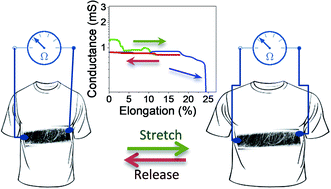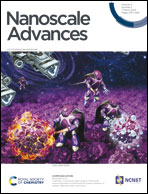Metal nanowires grown in situ on polymeric fibres for electronic textiles†
Abstract
A key aspect of the use of conventional fabrics as smart textiles and wearable electronics is to incorporate a means of electrical conductivity into single polymer fibres. We present the transformation of thin polymer fibres and fabrics into conductive materials by in situ growth of a thin, optically transparent gold–silver nanowire (NW) mesh with a relatively low metal loading directly on the surface of polymer fibres. Demonstrating the method on poly(lactic-co-glycolic) acid and nylon microfibres, we show that the NW network morphology depends on the diameter of the polymer fibres, where at small diameters (1–2 μm), the NWs form a randomly oriented network, but for diameters above several micrometers, the NWs wrap around the fibres transversally. This phenomenon is associated with the stiffness of the surfactant templates used for the NW formation. The NW-decorated fibres exhibit a significant increase in conductivity. Moreover, single fibres can be stretched up to ∼15% before losing the electrical conductivity, while non-woven meshes could be stretched by about 25% before losing the conductivity. We believe that the approach demonstrated here can be extended to other polymeric fibres and that these flexible and transparent metal-coated polymer fibres could be useful for various smart electronic textile applications.



 Please wait while we load your content...
Please wait while we load your content...